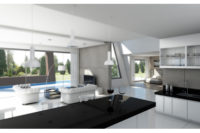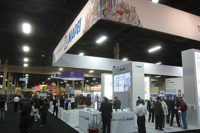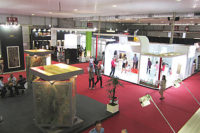What makes Salone and EuroCucina unique is the vast amount of floor space devoted to kitchen and bath displays. Full working kitchens -- often with chefs demonstrating the latest culinary innovations -- are brought to this one location to sell, impress and to set trends.
Nowhere else in the world would trade show attendees have to get special tickets and pass through a night club line, complete with menacing bouncers, simply to view designer kitchens from Fendi, Armani and more. The sheer scale of the event forces manufacturers to push the limit, as this is their window to shine and define sales for the next two years.
New in Countertops
According to kitchen and bath designer Gloria Graham-Sollecito, "Countertops were either very thin (1/2 inch) or chunky (3 inches) with a lot of mixing of materials, in fact, that was probably the one biggest trend I saw for both countertops and cabinets. It is also one that can easily be adapted to our U.S. market. Countertop materials are much more adventurous than the usual granite or quartz that we are used to here. I saw wood, Corian, recycled composite material and more. Overlapping installation was also quite common."
Dekton by Cosentino
Aninnovative new ultra-compact surface capable of seamless indoor and outdoor use that features advanced technical properties and functionality. Byutilizing Particle Sintering Technology, a proprietary technique that mimics the metamorphic change that rocks and stone undergo in nature when subjected to heat and pressure over thousands of years, Dekton offers UV and thermal shock resistance, superior strength, high resistance to impact, scratches and abrasion, and low water absorption. Produced in large format slabs, measuring approximately 126 inches x 56 inches, Dekton allows for large-scale interior and exterior applications. Dekton is available in 10 white, gray, black and natural stone hues, and in three polished, matte and slate finishes. www.dekton.com/
Core-A by Leicht
The new "Core-A" front (available in artic, frosty white and mohair) is just 4 mm thick. It features a solid black compact laminate core visible at the edges. Slim-line 10 mm panels and an island worktop that is also only 10 mm thick made of the same solid laminate material as the kitchen fronts now also feature in the current Leicht range. Here too the black core of the laminate is visible. Not only is every individual front given a delicate framework, but the horizontal and vertical lines of the kitchen's design are accentuated, too.www.leicht.com/en/
New in tile
There is an increasing trend towards vintage and industrial looks in tile. Valcucine evenincorporated iconic hydraulic cement looks into their Logica cabinet fronts.
Nanoregeneration by Aparici
Aparici displayed its new Nanoregeneration Collection inspired by the industrial aesthetic of 1950's factories. They call it "industrial minimalism with an old soul." This new collection is defined by neutral colors, which oscillate from black through gray and white. This collection, with an industrial recycled coating feature, allows surfaces to provide functionality without losing originality.
Cocciopesto Worktop by Minacciolo
Although Cocciopesto’s origins are ancient and come from the crushing of bricks, this classic top is the result of careful research and development. The materials for the "Minà" collection are original, innovative and exclusive and are created by local artisans.
New in sinks
In the kitchen sink category, SteelArt PRECISION™, SILGRANIT® and ATTIKA stainless sinks from Blanco were present in almost 50% of the kitchen manufacturers at the show. Professional grade sinks by Blanco and others, like Franke, were featured because they are ultra functional and sleekly engineered. Personalized sink accessories such as colanders, knife holders and integrated cutting boards were also highlighted, even when the sink shown was made of marble. Fabrication at shows like this are often flush mount and not representative of U.S. market installations -- although there were far more undermount sinks with integrated cutting boards versus the typical worktop drainboards seen at other international
ATTIKA by BLANCO
Blanco's new award-winning ATTIKA™ kitchen sink presents strong architectural character with its elegant and one-of-a-kind elevated rim geometry. The exclusive raised rim offers a completely new look tailored for architecturally–minded individuals, designers and builders.ATTIKA showcases the true artistry that is Blanco SteelArt, featuring anelegant and exclusive frame with contemporary R10 radius corners. www.blancoamerica.com
Marble Kitchen by Werkhaus
The Werkhaus Marble Kitchen is carved as a single uninterrupted piece from solid rock, using a striking technique that shows off the front in its natural state. The sink is carved out of the marble and a cooktop is integrated flush into the island.
For bathrooms, above the counter vessels are more popular in Europe and dominated the displays. Functional accessories are also making their way into bath sinks with integrated storage above faucets and in sinks.
SaphirKeramikby Laufen
Exceptional hardness and strength are not what you would think of when looking at the ultra thin walled SaphirKermik washbasin by Laufen – but an innovative formulation offers unprecedented possibilities with edge radii of 1 to 2 mm. The hardness of the high-performance material is achieved by adding the mineral corundum (AI2O3), which is colorless in its pure form. By mixing the clay with the silicate raw material, SaphirKeramik acquires a bright white color. Laufen can use a thinner ceramic body and a simpler structure to reduce the weight compared with conventional ceramic. The benefits are manifold: lower raw material costs and energy consumption in production and transportation.






